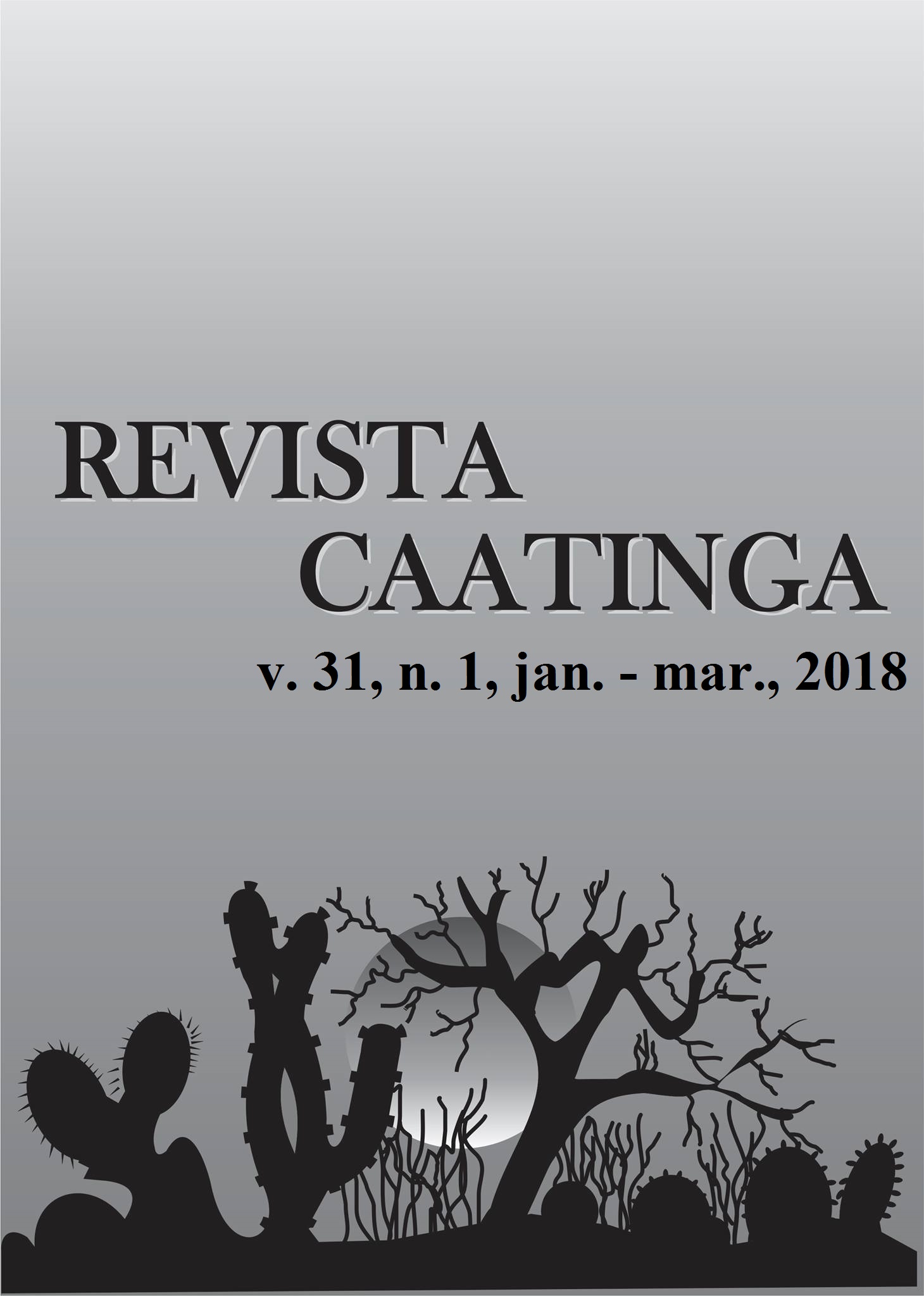THE INFLUENCE OF CLADODE MORPHOLOGY ON THE CANOPY FORMATION OF FORAGE CACTUS PLANTS
DOI:
https://doi.org/10.1590/1983-21252018v31n121rcKeywords:
Statistical analysis. Clones. Biometrics data. Nopalea sp.. Opuntia sp..Abstract
Here we aimed to evaluate the influence of cladode morphology on the canopy formation of forage cactus plants. The study was carried out in Serra Talhada, the State of Pernambuco, using the IPA Sertânia (IPA), Miúda (MIU), and Orelha de Elefante Mexicana (OEM) clones, which were submitted to three irrigation depths (2.5, 5.0, or 7.5 mm) and three irrigation intervals (7, 14, or 28 days) from March 2012 to August 2013. Cladode and plant canopy biometric data were obtained during the experimental period. We found that the characteristics of the second and third order cladodes contributed most to the canopy formation of clones of the genus Nopalea (IPA and MIU), whereas, for the genus Opuntia (OEM), the first and third order cladodes contributed most. Overall, we found that the influence of the cladode variables on the canopy growth of forage cactus is more associated with the characteristics of the genus than to the peculiarities of the clones.Downloads
References
BRUM, B. et al. Correlações canônicas entre variáveis de semente, plântula, planta e produção de grãos em mamoneira. Ciência Rural, Santa Maria, v. 41, n. 3, p. 404-411, 2011.
CAVALCANTE, L. A. D. et al. Respostas de genótipos de palma forrageira a diferentes densidades de cultivo. Pesquisa Agropecuária Tropical, Goiânia, v. 44, n. 4, p. 424-433, 2014.
CRUZ, C. D. Programa Genes: biometria. 1. ed. Viçosa, MG: Editora UFV, 2006. 382 p.
CUNHA, D. N. F. V. et al. Morfometria e acúmulo de biomassa em palma forrageira sob doses de nitrogênio. Revista Brasileira de Saúde e Produção Animal, Salvador, v. 13, n. 4, p. 1156-1165, 2012.
FERREIRA, D. F. Estatística Multivariada. 2. ed. Lavras, MG: Editora UFLA, 2011. 675 p.
FLORES-HERNÁNDEZ, A. et al. Yield and physiological traits of prickly pear cactus ‘nopal’ (Opuntia spp.) cultivars under drip irrigation. Agricultural Water Management, Amsterdam, v. 70, n. 1, p. 97-107, 2004.
GIBSON, et al. Exploiting leaf starch synthesis as a transient sink to elevate photosynthesis, plant productivity and yields. Plant science, Amsterdam, v. 181, n. 3, p. 275-281, 2011.
NEDER, D. G. et al. Correlations and path analysis of morphological and yield traits of cactus pear accessions. Crop Breeding and Applied Biotechnology, Amsterdam, v. 13, n. 3, p. 203-207, 2013.
NOBEL, P. S. Ecophysiology of Opuntia ficus-indica. In: MONDRAGÓN-JACOBO, C.; PÉREZ-GONZÁLEZ, S. (Eds.). Cactus (Opuntia spp.) as forage. Rome: Food and Agriculture Organization of the United Nations, 2001. p. 13-20. (FAO Plant production and protection paper, 169).
PEÑA-VALDIVIA, C. B. et al. Morphological characterization of Opuntia spp.: a multivariate analysis. Journal of the Professional Association for Cactus Development, Chapingo, v. 10, n. 1, p. 1-21, 2008.
PINHEIRO, K. M. et al. Correlações do índice de área do cladódio com características morfogênicas e produtivas da palma forrageira. Pesquisa Agropecuária Brasileira, Brasília, v. 49, n. 12, p. 939-947, 2014.
QUEIROZ, M. G. et al. Características morfofisiológicas e produtividade da palma forrageira sob diferentes lâminas de irrigação. Revista Brasileira de Engenharia Agrícola e Ambiental, Campina Grande, v. 19, n. 10, p. 931-938, 2015.
SILVA, C. C. F.; SANTOS, L. C. Palma Forrageira (Opuntia fícus-indica Mill) como alternativa na alimentação de ruminantes. Revista Electrónica de Veterinária, Málaga, v. 7, n. 10, p. 1-13, 2006.
SILVA, N. G. M. et al. Relação entre características morfológicas e produtivas de clones de palma-forrageira. Revista Brasileira de Zootecnia, Viçosa, v. 39, n. 11, p. 2389-2397, 2010.
SILVA, T. G. F. et al. Indicadores de eficiência do uso da água e de nutrientes de clones de palma forrageira em condições de sequeiro no Semiárido brasileiro. Bragantia, Campinas, v. 73, n. 2, p. 184-191, 2014a.
SILVA, T. G. F. et al. Área do cladódio de clones de palma forrageira: modelagem, análise e aplicabilidade. Revista Brasileira de Ciências Agrárias, Recife, v. 9, n. 4, p. 633-641, 2014b.
SILVA, T. G. F. et al. Crescimento e produtividade de clones de palma forrageira no semiárido e relações com variáveis meteorológicas. Revista Caatinga, Mossoró, v. 28, n. 2, p. 10-18, 2015.
THOMAZ, G. L. et al. Produção do girassol e teor de óleo nos aquênios em função da temperatura do ar, precipitação pluvial e radiação solar. Ciência Rural, Santa Maria, v. 42, n. 8, p. 1380-1385, 2012.
TOEBE, M.; CARGNELUTTI FILHO, A. Não normalidade multivariada e multicolinearidade na análise de trilha em milho. Pesquisa Agropecuária Brasileira, Brasília, v. 48, n. 5, p. 466-477, 2013.
WEERAKKODY, W. A. P.; SURIYAGODA, L. D. B. Estimation of leaf and canopy photosynthesis of pot chrysanthemum and its implication on intensive canopy management. Scientia Horticulturae, Amsterdam, v. 192, n. 1, p. 237-243, 2015.
Downloads
Published
Issue
Section
License
Os Autores que publicam na Revista Caatinga concordam com os seguintes termos:
a) Os Autores mantêm os direitos autorais e concedem à revista o direito de primeira publicação, com o trabalho simultaneamente licenciado sob a Licença Creative Commons do tipo atribuição CC-BY, para todo o conteúdo do periódico, exceto onde estiver identificado, que permite o compartilhamento do trabalho com reconhecimento da autoria e publicação inicial nesta revista, sem fins comerciais.
b) Os Autores têm autorização para distribuição não-exclusiva da versão do trabalho publicada nesta revista (ex.: publicar em repositório institucional ou como capítulo de livro), com reconhecimento de autoria e publicação inicial nesta revista.
c) Os Autores têm permissão e são estimulados a publicar e distribuir seu trabalho online (ex.: em repositórios institucionais ou na sua página pessoal) a qualquer ponto antes ou durante o processo editorial, já que isso pode gerar alterações produtivas, bem como aumentar o impacto e a citação do trabalho publicado (Veja O Efeito do Acesso Livre).







